-

人教版新课标PEP小学英语五年级下册What Are You Doing教案
教学参考时间:2—3分钟教师让学生说出几个家庭成员名称,如:father, mother, sister, brother, uncle等,自己或让学生把单词写在黑板的一侧,再让学生说出几个动词短语的-ing形式,如:washing clothes, writing an e-mail, watching TV等,写到黑板的另一侧。学生在家庭成员名称和动词短语中分别选三至四个,自己编成一首歌谣。课后,可以让学生将创作的歌谣进行展示或举行歌谣朗读比赛。5、Consolidation and extension (扩展活动)活动十:知识扩展教学参考时间:1—2 分钟教师让学生打开书第54页Good to know 部分,了解主要国家的紧急救助电话。如:美国,英国,加拿大,澳大利亚等。教师还帮助学生了解我国的紧急救助电话号码。教师可以利用道具电话让学生做游戏。活动十一:练一练教学参考时间:2—3 分钟做本单元B Let’s talk部分的活动手册第37页的配套练习。教师讲解题目要求。教师播放录音,做Listen and number 部分练习。要求按所听内容在图上写出序号。再次播放,让学生按录音内容填空。鼓励学生自己读读所写句子。
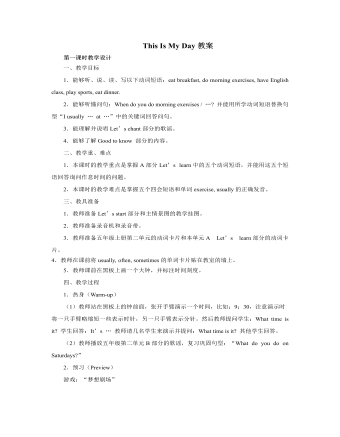
人教版新课标PEP小学英语五年级下册This Is My Day教案
学生初步了解对话内容,在描述中培养学生的语言运用能力。(2)教师让学生自己阅读本部分对话,不理解的生词和句子可以和同学或老师共同商讨。(3)教师帮助学生理解句子:“The weather report says it’s going to rain tomorrow. I can’t play football in the rain. I can’t go hiking, either. Let’s watch TV together.”出示图片:1) 晴天,Zoom在踢足球,图下显示:today;2)天在下雨,Zoom和Zip在屋里看电视,图下显示:tomorrow。与学生展开对话T:What’s the weather like today? S:It’s fine/ sunny. T:What does the weather report say about tomorrow?S:It’s going to rain.T:The weather report says it’s going to rain tomorrow.(呈现句子)(学生重复句子The weather report says it’s going to rain tomorrow.,并说出意思。)T:Can you play football in the rain?S:No,I can’t.T:Can you go hiking ?S:No,I can’t.T:In the rain, we can’t play football. We can’t go hiking, either. (呈现:either)学生跟读either,感悟单词的用法,教师讲解意思:(不......),也不...启发学生用either说两句话:In the rain, I can’t ... I can’t ..., either,从而在应用中巩固单词的读音和用法。

人教版新目标初中英语七年级下册How was your weekend教案2篇
Teaching Goal:1. General aims:Talk about recent past events2. Particular aims:A. Language Focus.Talk about recent past events and think of the past events.B. Language goalsHow was….?It was …What did …do over the weekend?C. Language structures:(1). How was your weekend? I was great. Pay attention to no form.(2). What did you do over the weekend? I played soccer. We went to the beach.D. Useful words and phrases:Words: was, did, went, beach, over, project, test, wasn’t, false, number, geography, spend, week, most, mixture, their, had, little, cook, read, saw, change, everyone, sit, sat, no, anythingPhrases: did one’s homework, played soccer, cleaned my room, went to the beach, played tennis, went to the movies, on Saturday morning, over the weekend, cook … for, what about, do some reading, have a party, talk show, go shoppingE. Grammar language:Present simple past tenseRegular and irregular verbsF. Learning strategies:Tour and holidaysG. Interdiscipinary:H. Emotion and manner:Teaching time: 5 periodsTeaching procedures:Period One教学步骤、时间 教师活动 学生活动 媒体应用Step 1Free talk 3’ Ask some questions like:Who’s on duty today?What’s the weather like? Answer and talk about something.让同学们回答下列问题1. Do you like weekend? (Let some students answer)It takes them three minutes to talk about the question.2. Why do you like weekend? (let the students answer) Most of the students like the weekend此时教师用汉语问:“在周末期间问你干了什么?这句话用英语这么回答?Let the students guess.At last the teacher give them right answer3. What did you do over the weekend?(板书、学习)
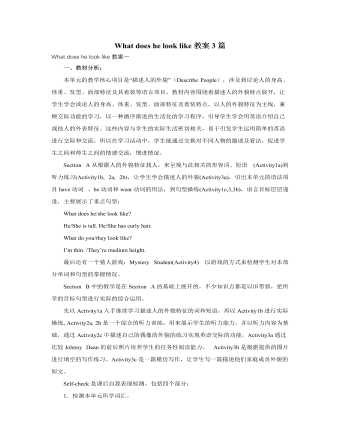
人教版新目标初中英语七年级下册What does he look like教案3篇
所需要用到的句子:Who is that?That is Jack. I like him.Why do you like him?I like him because he is interesting.Task 4: 设计理想中的人类Step one: 设计理想中的人类的外貌。把全班同学分成若干小组,学生可以边说边在纸上画出他们的模样。Step two: 设计理想中人类的性格。学生们可以把那些能描述性格的单词写在图画的旁边。Step three: 每组选出一名同学,其他同组同学提问,他作简单回答,并说明原因。所需用到的句子:What does he or she look like?He or she ...What is he or she like?He or she is ...Why?Because ...Task 5: 挑战性活动调查性格是天生的还是后天形成的,让每个同学回家去调查一下自己成长过程中性格是否有变化,具体是怎样的,为什么会这样? Teaching Aims:1. Enable students to have a general understanding of how to talk about people's physical appearance.2. Enable students to tackle some essential vocabularies and patterns about describing people. Provide them with necessary skills and methods.3. Create various chances for students to describe the persons they're familiar with, such as classmates, family members, teachers, idols, etc.
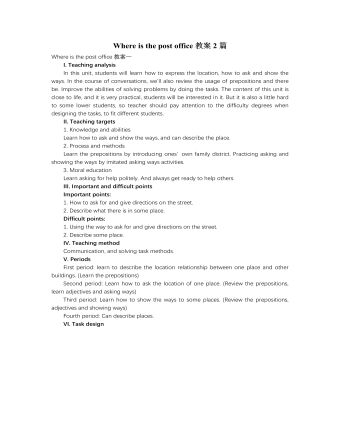
人教版新目标初中英语七年级下册Where is the post office教案2篇
Period 2 (3a----Section B 2c)Preview(Pre-task): Key points: What laAdd another information about their pen pals----their language on the cardnguage does she/he speak?She/He speaks....Does she/he have any brothers and sisters? Does she/he speak English?Preview(Pre-task): Add another information about their pen pals----their language on the cardKey points: What language does she/he speak?She/He speaks....Does she/he have any brothers and sisters? Does she/he speak English?Step 1 Revision1.Revisionand dictation of the new words 2.Revise the drills they learned yesterday.(by pairwork and grammar exercise)Step 2 Leading-inT has a conversation with one student. The conversation is following:---Do you have a pen pal?---Yes, I do.---What's your pen pal's name? ---His/Her name is....---Where is your pen pal from? ---He/She is from...---Where does he/she live? ---He/She lives in....---What language does he/she speak?He/She speaks...Write the new words on the Bb. They are following: EnglishChineseJapaneseFrenchStep 3 LearnLearn the new words with the whole class.Finish 3a with the students3b Pairwork T still does an example with one student Then the Ss practise in pairs. The example is following:--Curry Muray is my pen pal. He is from the United States.---What language does he speak?
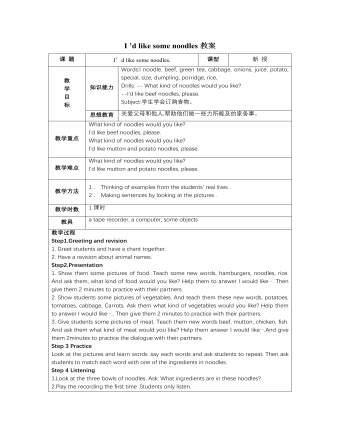
人教版新目标初中英语七年级下册I ’d like some noodles教案
教学过程Step 1: warming-up Sing a song---------“food and drink” Step 2: Revision1 Dictation2 Revise: What kind of noodles would you like?I’d like …What size bowl of noodles would you like?I’d like…Step 3: Presentation1 show pictures of food, ask students say the words.2 Students read the newspaper ad in 3a. Fill in blanks with words in the box. Then read the ad together, the teacher explains some difficult language points.3 Check the answers Step 4 PracticeAsk students to finish 3b in the same way according to 3a. Students read the short passage and fill in the blanks .At last, check the answers.Step 5 productionAsk students to write their own ad for dumplings, noodles, drinks, and other foods they know. Then ask students to read their partner’s ad. Then order food and drink from their partner.Step 6 Home workGroup work – make an ad about “food and drink”
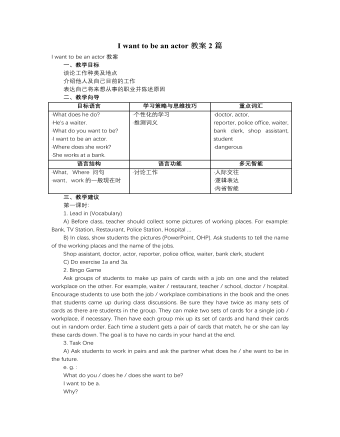
人教版新目标初中英语七年级下册I want to be an actor教案2篇
三、教学建议第一课时:1. Lead in (Vocabulary)A) Before class, teacher should collect some pictures of working places. For example: Bank, TV Station, Restaurant, Police Station, Hospital ...B) In class, show students the pictures (PowerPoint, OHP). Ask students to tell the name of the working places and the name of the jobs.Shop assistant, doctor, actor, reporter, police office, waiter, bank clerk, studentC) Do exercise 1a and 3a.2. Bingo GameAsk groups of students to make up pairs of cards with a job on one and the related workplace on the other. For example, waiter / restaurant, teacher / school, doctor / hospital. Encourage students to use both the job / workplace combinations in the book and the ones that students came up during class discussions. Be sure they have twice as many sets of cards as there are students in the group. They can make two sets of cards for a single job / workplace, if necessary. Then have each group mix up its set of cards and hand their cards out in random order. Each time a student gets a pair of cards that match, he or she can lay these cards down. The goal is to have no cards in your hand at the end.3. Task OneA) Ask students to work in pairs and ask the partner what does he / she want to be in the future.e. g. :What do you / does he / does she want to be?I want to be a.Why?Because it's (adj).B) Vocabulary: Section B, 1a4. Homework 1.2.
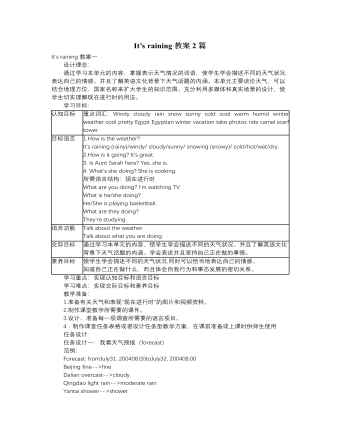
人教版新目标初中英语七年级下册It’s raining教案2篇
1 Each group choose one place to describe and what you are doing in it Choose one place, and describe what they are doing 2 Move around the room and give suggestions Talk about it and write it down 3 Ask one to show their works and act it Choose one of each group to make a report 4 Evaluate the best group and the best reporter Choose the best one Homework Ask your friends their ideal place and write about it教学反思:新课程标准中强调学生在课堂中的主体地位,在综合课中他们的主体地位就更加突出。在各个活动中给不同程度的学生不同层次的任务,让各层面的学生都有表现发挥的机会,从而产生对英语的兴趣。使用照片图片多媒体来辅助教学,效果更好。同时让了解其他国家风景,风俗的同学介绍ideal place,增加学生的背景知知识,实现跨学科交流的目的。教案点评:采用任务型教学模式,在各个活动中给不同程度的学生不同层次的任务,让各层面的学生都有表现发挥的机会,从而产生对英语的兴趣。使用照片图片多媒体来辅助教学,效果更好。让了解其他国家风景,风俗的同学介绍ideal place,增加学生的背景知识,实现跨学科交流的目的。
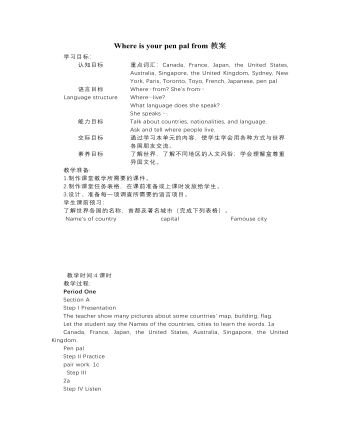
人教版新目标初中英语七年级下册Where is your pen pal from教案
2.1Match the country with the language.Step II Reading3a? let the students read the letter fast and answer the questions.? Let the students ask more questions about the letter as possible as the can.Step III Writing3b.Step IV. Pairwork2cStep V Listening2a, 2bStep V. HomeworkExercises book(1) P3Exercises book (2) P3Period FourStep I . Dictate the words and sentences in Unit1.Step II. Self-checkStep III. Check the answers for Exercises book in the unit.Step IV. Home workRevise and preparation for unit 2.教学反思:通过本单元的学习,学生基本可以谈论人们的国籍,居住城市及其所说的语言,通过书信方式去介绍自己并寻找笔友。但在涉及到国外的一些城市时,学生对这方面的知识相对欠缺,能介绍的城市并不多,也反应出学生课前预习不充分,这跟学生学习条件也有关,大多数学生无法通过网络获取所需信息。因此,在以后的教学中要多指导学生通过计算机网络获取信息,拓宽知识面。
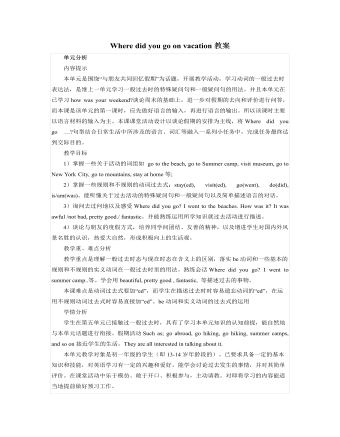
人教版新目标初中英语七年级下册Where did you go on vacation教案
句型: Where did you go on vacation? I went to summer camp.Did she go to Central Park?Yes,she did.No, she didn’t语法:一般过去时特殊疑问句、一般疑问句及肯、否定回答。课时安排4课时第一课时:Section A:la,1b,lc,2a,2b,2c 第二课时:Section A:3a,3b,4第三课时:Section B:1,2a,2b,2c第四课时:Section B:3a,3b,3c,4 and Self Check第一课时教学目标掌握描写假期生活的形容词。假期里自己所做事情的简单表达。谈论假期做的事情及当时情况。谈论假期时旅游的天气,旅游者以及食物等。教学过程一、导入播放一首英文歌曲:Let’s travel 说明:通过让学生听节奏欢快迪斯尼英语歌曲Let’s travel.引入本节课谈论的话题vacation and travel. 让歌曲使学生的思维活跃,增强课堂气氛,激发学生提高学习英语的兴趣。T:How is the trip ?Ss : It’s pretty good/ happy/exciting /relaxing/busy/dangerous/ fantastic说明:这个问题是为了操练形容词。建议让多个Ss作答。鼓励他们用不同的形容词。上述个别形容词本应在第二课时中出现,但可以在warming-up中第一次非正式出现。这些形容词也可在老师的评价语中适时出现,以加深学生对词汇的印象。

人教版新目标初中英语七年级下册Why do you like koalas教案2篇
单元整体说明(一)单元教材分析本单元的核心话题是描述动物和表达个人喜好,以及句式why do you like…? Because…。这也是本单元的教学重点。通过本单元的学习,学生应能较流利地运用所学词汇和句型描述动物,表达个人喜好。(二)单元知识结构1.词汇动物名称 tiger, elephant, koala, dolphin, etc.词汇描述性形容词: smart, cute, ugly, clever, shy, etc.国家名: Australia, South Africa2.句型Why do you like koala hears? Because they are cute.Where are pandas from? They're from China.What animals do you like? I like dolphins.(三)单元整体目标1.Master the vocabulary2.Master and use: Why do you like koalas? Because they am cute.Where are pandas from? They're from China.What animals do you like? I like dolphins.(四)单元教学重难点一览(五)单元学情分析学生此前已经学过由why, where, what 引导的特殊疑问句句型,具有了学习本单元知识的认知前提。形形色色的动物能激发学生的好奇心,产生了解它们的欲望,这有利于本单元知识的教学和学生学习兴趣的培养。
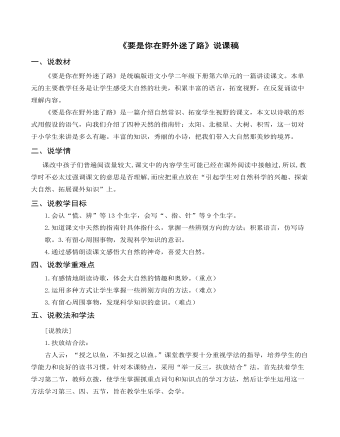
(说课稿)《要是你在野外迷了路》部编人教版二年级上册语文
六、说教学过程(一)创设情境,激趣导入 一堂课的开始,为了使学生尽快地进入学习状态,在情境创设中,应该做到新颖,要让学生感受到一种新的情境,从而产生好奇心,达到集中注意力的目的。教学开始,我首先创设情境,提出了两个问题:1.如果你在大街上迷路了,你会怎么做?2.如果你在野外迷了路,你又会怎么做?【设计意图】这两个问题的提出让学生区分在不同的地点迷了路要用不同的方法。然后我顺势导入课文:我们来学习课文,看看如果在野外迷了路,有什么办法分辨方向。(二)初读课文,整体感知 1.让学生自由读课文,要求把字音读准,把句子读通顺。然后老师范读一遍,让学生注意听老师是怎么读的,如字音、节奏等。2.再次自由读课文,按着老师的方法读诗歌,然后把本课的生字读一遍。【设计意图】这样,学生对于课文的生字和大概内容就有了一个整体印象,培养了他们的自学能力。
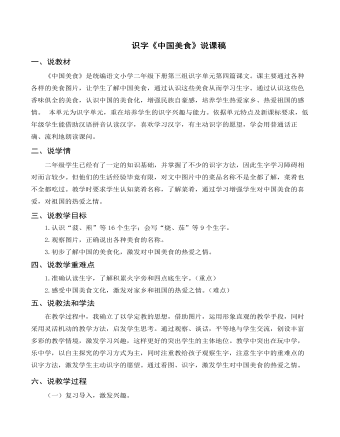
(说课稿)识字《中国美食》部编人教版二年级上册语文
一、说教材《中国美食》是统编语文小学二年级下册第三组识字单元第四篇课文。课主要通过各种各样的美食图片,让学生了解中国美食,通过认识这些美食从而学习生字。通过认识这些色香味俱全的美食,认识中国的美食化,增强民族自豪感,培养学生热爱家乡、热爱祖国的感情。 本单元为识字单元,重在培养学生的识字兴趣与能力。依据单元特点及新课标要求,低年级学生能借助汉语拼音认读汉字,喜欢学习汉字,有主动识字的愿望,学会用普通话正确、流利地朗读课问。二、说学情二年级学生已经有了一定的知识基础,并掌握了不少的识字方法,因此生字学习障碍相对而言较少。但他们的生活经验毕竟有限,对文中图片中的菜品名称不是全都了解,菜肴也不全都吃过。教学时要求学生认知菜肴名称,了解菜肴,通过学习增强学生对中国美食的喜爱,对祖国的热爱之情。
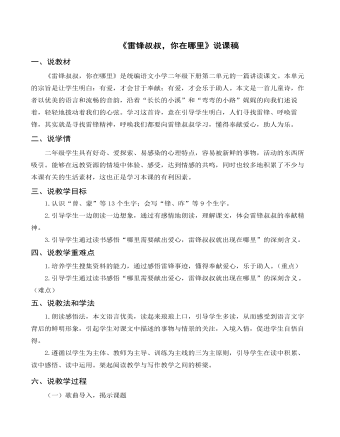
(说课稿)《雷锋叔叔,你在哪里》部编人教版二年级上册语文
三、说教学目标1.认识“曾、蒙”等13个生字;会写“锋、昨”等9个生字。2.引导学生一边朗读一边想象,通过有感情地朗读,理解课文,体会雷锋叔叔的奉献精神。3.引导学生通过读书感悟“哪里需要献出爱心,雷锋叔叔就出现在哪里”的深刻含义。四、说教学重难点 1.培养学生搜集资料的能力,通过感悟雷锋事迹,懂得奉献爱心,乐于助人。(重点)2.引导学生通过读书感悟“哪里需要献出爱心,雷锋叔叔就出现在哪里”的深刻含义。(难点)五、说教法和学法1.朗读感悟法,本文语言优美,读起来琅琅上口,引导学生多读,从而感受到语言文字背后的鲜明形象,引起学生对课文中描述的事物与情景的关注,入境入情,促进学生自悟自得。2.遵循以学生为主体、教师为主导、训练为主线的三为主原则,引导学生在读中积累、读中感悟、读中运用。架起阅读教学与写作教学之间的桥梁。
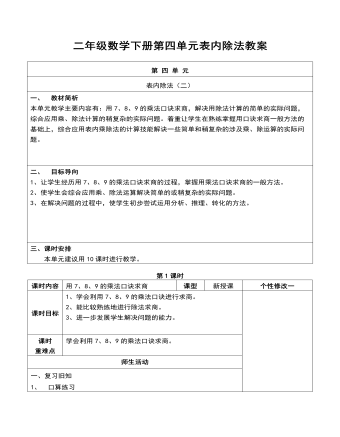
二年级数学下册第四单元表内除法教案
1、 谈话引入新课六一快到了。小朋友们在老师的带领下忙着布置自己的教室呢!可是他们遇到了一些数学上的问题,你能帮他们一快解决吗?2、教学例1。(1)、投影出示主题图引导学生仔细观察。说说他们遇到了什么问题?(2)、引导学生解决问题并列出算式。板书:56÷8(3)、引导学生得出算式的商。问:你是怎么计算的?(想乘算除)(4)、学生独立解决:要是挂7行呢?你能够解决吗?学生说出自己的计算结果,并把求商的过程跟大家说一说。2、 小结:在今天的学习中我们不仅帮小朋友们解决了数学问题,而且还进一步学会了利用乘法口诀来求商。在以后的除法中只要大家能够熟记口诀,就能很快算出除法的商了。
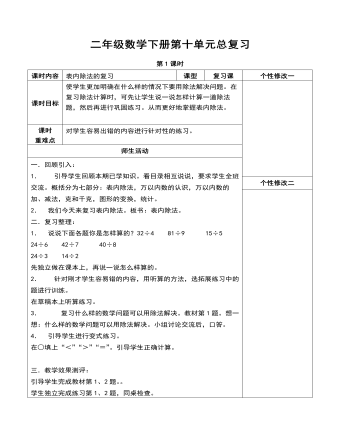
二年级数学下册第十单元总复习教案
1、复习万以内数的认识。 请同学们先来回忆一下,我们学了万以内数的哪些知识? 回忆学了万以内数的数数、读数、写数、数的组成、数位的含义、数的顺序和大小比较、近似数以及整百、整千数的加减法……2、下面先请大家独立做教材第3题,然后集体订正。 指名让学生说一说是怎么做的?3、写一写,再读一读。① 千位上是2个千、百位上是5个百、个位上是6个一。② 二千五百零六。4、 下面复习用计数单位表示数,独立完成书上第4题,想一想是怎样做出来的。5、 复习近似数。请同学们看教材第5题,找出这段文字中哪些数是近似数?并画出来。再请同学回答。
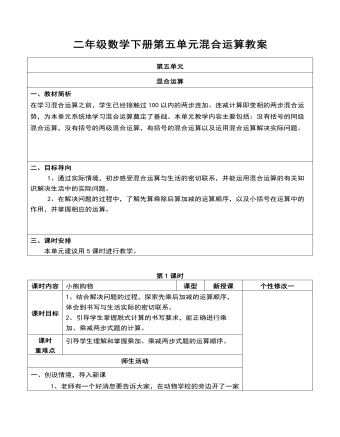
二年级数学下册第五单元混合运算教案
一、创设情境,导入新课 1、老师有一个好消息要告诉大家,在动物学校的旁边开了一家超市,森林里的小动物们都去那儿购物。今天,小熊哥俩正在商店里购物呢!你想看看吗? 2、教师出示情境图,教师板书课题:小熊购物二、自主探究新知 1、解决第(1)个问题“小熊该付多少钱?” 1)“仔细观察情境图,你能发现哪些数学信息?”,教师总结重要数学信息。 2)“ 大家看小熊说的话,你能提出什么问题?” 引出“小熊该付多少钱?”这个问题。 3),教师巡视搜集学生出现的不同做法 4)展示学生作业,并引导其他学生质疑“第二个算式是什么意思?”若学生中不出现第二个算式,教师引导学生将两个算式合在一起。 5)脱式计算:根据学生列出的算式,教师结合算式指导学生进行脱式计算,规范学生的书写格式。
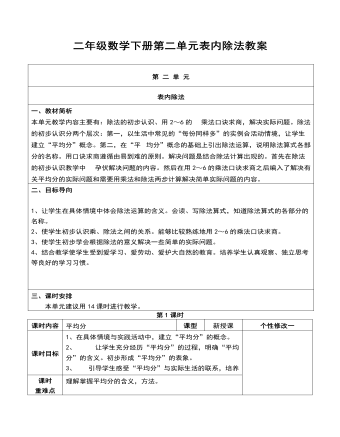
二年级数学下册第二单元表内除法教案
一、教材简析 本单元教学内容主要有:除法的初步认识、用2~6的 乘法口诀求商,解决实际问题。除法的初步认识分两个层次:第一,以生活中常见的“每份同样多”的实例合活动情境,让学生建立“平均分”概念。第二,在“平均分”概念的基础上引出除法运算,说明除法算式各部分的名称。用口诀求商遵循由易到难的原则。解决问题是结合除法计算出现的。首先在除法的初步认识教学中 孕伏解决问题的内容。然后在用2~6的乘法口诀求商之后编入了解决有关平均分的实际问题和需要用乘法和除法两步计算解决简单实际问题的内容。
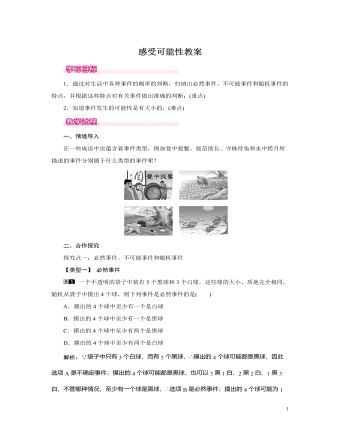
北师大初中七年级数学下册感受可能性教案
一个不透明的袋子中装有5个黑球和3个白球,这些球的大小、质地完全相同,随机从袋子中摸出4个球,则下列事件是必然事件的是( )A.摸出的4个球中至少有一个是白球B.摸出的4个球中至少有一个是黑球C.摸出的4个球中至少有两个是黑球D.摸出的4个球中至少有两个是白球解析:∵袋子中只有3个白球,而有5个黑球,∴摸出的4个球可能都是黑球,因此选项A是不确定事件;摸出的4个球可能都是黑球,也可以3黑1白、2黑2白、1黑3白,不管哪种情况,至少有一个球是黑球,∴选项B是必然事件;摸出的4个球可能为1黑3白,∴选项C是不确定事件;摸出的4个球可能都是黑球或1白3黑,∴选项D是不确定事件.故选B.方法总结:事件类型的判断首先要判断该事件发生与否是不是确定的.若是确定的,再判断其是必然发生的(必然事件),还是必然不发生的(不可能事件).若是不确定的,则该事件是不确定事件.

北师大初中七年级数学下册曲线型图象教案
解析:横轴表示时间,纵轴表示温度.温度最高应找到图象的最高点所对应的x值,即15时,A对;温度最低应找到图象的最低点所对应的x值,即3时,B对;这天最高温度与最低温度的差应让前面的两个y值相减,即38-22=16(℃),C错;从图象看出,这天0~3时,15~24时温度在下降,D对.故选C.方法总结:认真观察图象,弄清楚时间是自变量,温度是因变量,然后由图象上的点确定自变量及因变量的对应值.三、板书设计1.用曲线型图象表示变量间关系2.从曲线型图象中获取变量信息图象法能直观形象地表示因变量随自变量变化的变化趋势,可通过图象来研究变量的某些性质,这也是数形结合的优点,但是它也存在感性观察不够准确,画面局限性大的缺点.教学中让学生自己归纳总结,回顾反思,将知识点串连起来,完成对该部分内容的完整认识和意义建构.这对学生在实际情境中根据不同需要选择恰当的方法表示变量间的关系,发展与深化思维能力是大有裨益的





















